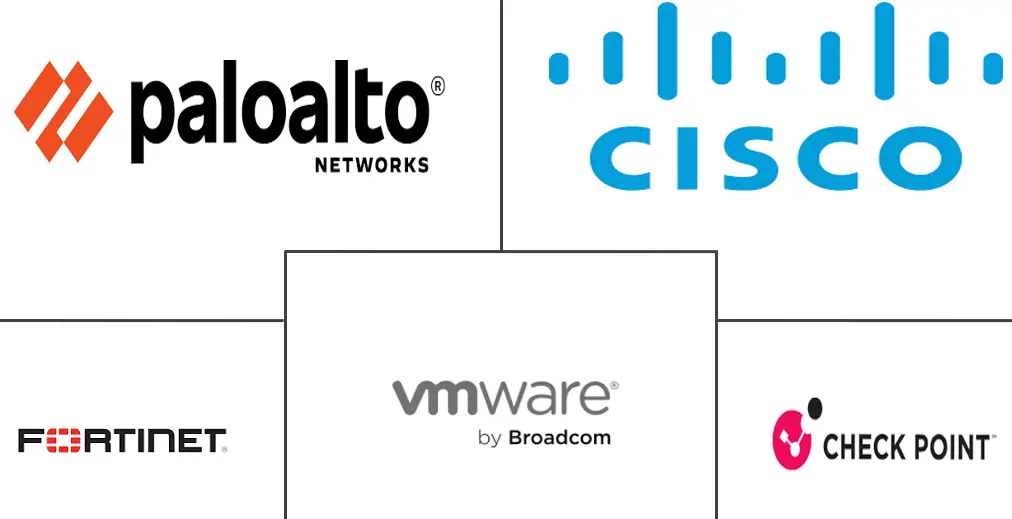Software Defined Security Market Size and Share

Software Defined Security Market Analysis by Mordor Intelligence
The software-defined security market size is estimated at USD 12.9 billion in 2025 and is forecast to more than double to USD 26.91 billion by 2030, advancing at a 15.84% CAGR. Most enterprises are moving away from perimeter-centric controls toward programmable architectures that follow workloads as they shift across data centers, multiple public clouds, and edge locations. Automated policy enforcement shortens incident-response cycles, while zero-trust principles embed continuous verification into everyday network operations. Regulatory deadlines such as the EU Cyber Resilience Act and the NIS2 Directive are converting discretionary spending into mandatory investments. At the same time, the rapid growth of containerized applications forces security teams to embrace granular micro-segmentation and runtime protection that only software-defined approaches can deliver. Together, these forces give the software-defined security market durable, double-digit momentum through the end of the decade.
Key Report Takeaways
- By component, software retained 63% of the software defined security market share in 2024; services are projected to expand at a 15.60% CAGR through 2030.
- By deployment model, public cloud held 39% revenue share in 2024; SaaS-only public cloud is expected to grow at an 18.20% CAGR to 2030.
- By security type, network security accounted for 40% of the software defined security market size in 2024, while cloud/container security leads growth at a 24% CAGR.
- By organization size, large enterprises commanded 58% share in 2024; small and medium enterprises are forecast to grow at a 13.80% CAGR.
- By end user, BFSI led with 24% revenue share in 2024; healthcare is the fastest-growing vertical at a 16.40% CAGR.
- By geography, North America captured 38% of revenue in 2024; Asia–Pacific is poised to expand at a 14.90% CAGR through 2030.
Global Software Defined Security Market Trends and Insights
Drivers Impact Analysis
| Driver | (~) % Impact on CAGR Forecast | Geographic Relevance | Impact Timeline |
|---|---|---|---|
| Requirement for quicker incident response and policy automation | +3.2% | Global, with concentration in North America & EU | Short term (≤ 2 years) |
| Rising adoption of multi-cloud & hybrid cloud architectures | +4.1% | Global, led by North America & APAC | Medium term (2-4 years) |
| Surge in container/Kubernetes security spend | +2.8% | APAC core, spill-over to North America & EU | Medium term (2-4 years) |
| Shift toward zero-trust & SASE convergence | +3.5% | Global, with early adoption in North America | Long term (≥ 4 years) |
| AI-driven threat-hunting reducing dwell time | +1.9% | North America & EU, expanding to APAC | Short term (≤ 2 years) |
| National cyber-resilience mandates after critical-infrastructure attacks | +2.7% | EU core, expanding globally | Long term (≥ 4 years) |
| Source: Mordor Intelligence | |||
Requirement for quicker incident response and policy automation
Mean time to detection must now be measured in minutes, not days. Coalition’s 2025 Cyber Threat Index found that 58% of ransomware intrusions began with compromised VPN devices, exposing the limits of manual responses. Enterprises therefore employ programmable security controls that auto-isolate endpoints once threat intelligence crosses defined risk thresholds. The financial stakes remain high: average breach costs in Canada reached USD 4.66 million and churn rates climbed to 38% among affected customers in 2025. Automated, software-defined playbooks let security teams scale without proportional head-count increases, aligning protection speed with adversary tempo. [1]Coalition, “Cyber Threat Index 2025 Finds Most Ransomware Incidents Start with Compromised VPN Devices,” coalitioninc.com
Rising adoption of multi-cloud and hybrid cloud architectures
Nutanix reports that 90% of global organizations now run a “cloud-smart” mix of private and multiple public clouds [nutanix.com]. Such diversity fragments visibility; 71% of teams acknowledge policy blind spots in at least one environment. Software-defined security platforms resolve that fragmentation by abstracting policy from the underlying infrastructure. Unified dashboards apply identical controls regardless of whether workloads run on-premises, AWS, Azure, or OCI, ensuring continuous compliance while giving developers freedom to place applications where they perform best. [2]Nutanix, “2025 Enterprise Cloud Index,” nutanix.com
Surge in container/Kubernetes security spend
Red Hat found that 67% of firms delayed production rollouts because container security gaps remained unresolved. Orchestrated microservices spin up and down in seconds, so legacy firewall rules cannot keep pace. Software-defined security tools discover ephemeral pods in real time, label them by function, and enforce micro-segmentation that follows every replica. As more enterprises push stateful services into Kubernetes, runtime protection and image-scanning features become non-negotiable budget items, lifting overall spend on software defined security market platforms.
National cyber-resilience mandates after critical-infrastructure attacks
The EU Cyber Resilience Act and NIS2 expand cybersecurity obligations across manufacturing, health, energy, and transport. Non-compliance can incur penalties up to 2.5% of worldwide turnover, so boards allocate new capital to programmable platforms capable of producing continuous audit trails. Similar supply-chain measures are under review in Japan, India, and Australia, suggesting a widening global pull for the software defined security market.
Restraints Impact Analysis
| Restraint | (~) % Impact on CAGR Forecast | Geographic Relevance | Impact Timeline |
|---|---|---|---|
| Shortage of DevSecOps talent | -2.1% | Global, acute in North America and EU | Long term (≥ 4 years) |
| Legacy-system interoperability issues | -1.8% | Global, pronounced in established enterprises | Medium term (2-4 years) |
| Hidden performance overhead in east-west micro-segmentation | -1.3% | Global, critical in high-performance environments | Short term (≤ 2 years) |
| Concentration risk from single-vendor policy controllers | -0.9% | Global, regulatory focus in EU & North America | Long term (≥ 4 years) |
| Source: Mordor Intelligence | |||
Shortage of DevSecOps talent
O’Reilly’s 2024 survey shows 38.9% of organizations citing cloud security skills as their biggest gap. DevSecOps engineer salaries in the United States already average USD 140,000, pressuring budgets and project timelines. Many firms backfill the gap with managed service providers, which boosts the services segment but slows in-house adoption of advanced features.
Legacy-system interoperability issues
Public-sector agencies still operate mainframes written in COBOL. ACT-IAC notes that maintenance of such code consumes a large share of total IT budgets. Because older platforms lack modern APIs, teams must deploy middleware that maps static firewall lists to dynamic policy engines, raising integration complexity and cost.
Segment Analysis
By Deployment Model: SaaS-Only Public Cloud Redefines Consumption
Public cloud continues to lead overall penetration, delivering 39% of 2024 revenue. Within that category, the SaaS-only slice is climbing fastest at an 18.20% CAGR. Smaller IT teams in particular prize the instant scaling and rolling updates that cloud-native vendors provide, since no on-premises appliances require patching. Larger enterprises also shift workloads into SaaS nodes to reduce capex and accelerate feature adoption as zero-trust frameworks mature.
On-premises deployments remain indispensable where sovereignty or latency mandates apply; however, hybrid designs increasingly route outbound traffic through SaaS secure web gateways. Combined, these trends move policy control toward the network edge and favour vendors that architect multi-tenant, elastic backplanes. The transition underscores the broader repositioning of the software defined security market from appliance sales to subscription revenue.
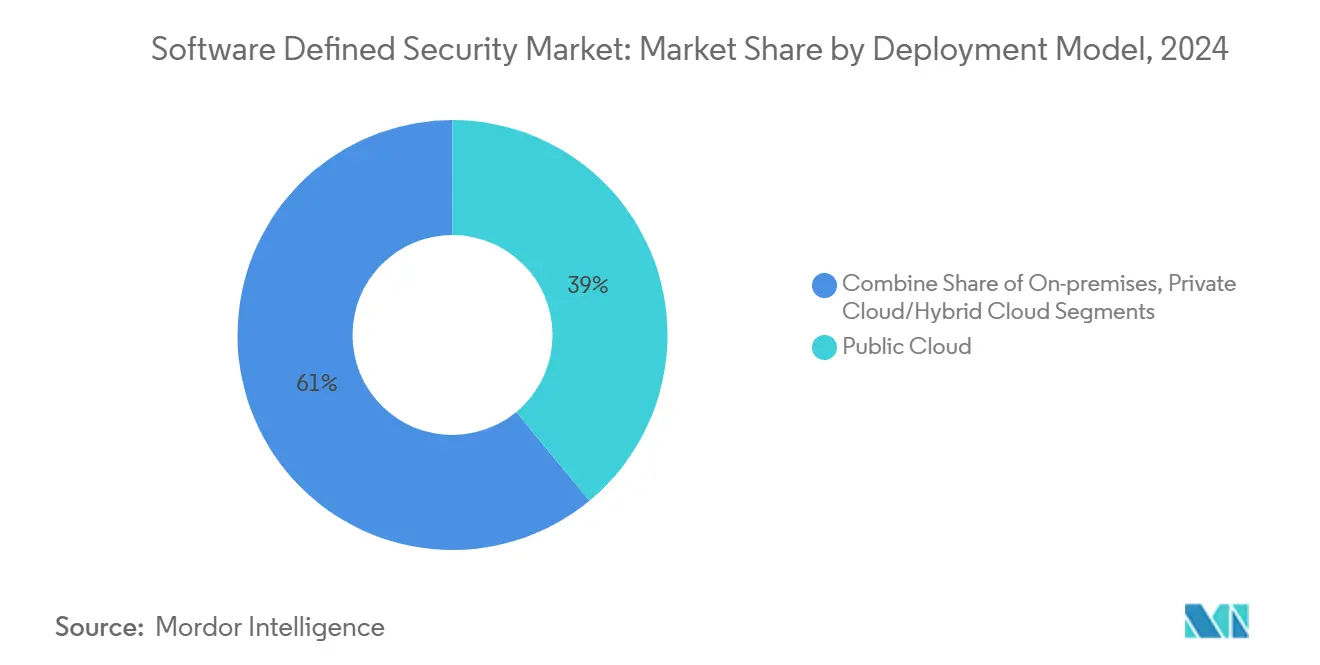
Note: Segment shares of all individual segments available upon report purchase
By Security Type: Cloud and Container Protection Becomes the Growth Engine
Network security still represents 40% of 2024 revenue, reflecting legacy firewall refresh cycles and software-defined wide-area network rollouts. The higher-growth story lies in cloud/container security, which will expand at a 24% CAGR through 2030. Development teams containerize monoliths into hundreds of microservices, so runtime controls must adapt in seconds as pods respawn. Continuous image scanning, admission-control hooks, and service-mesh encryption therefore top procurement lists.
Early adopters increasingly bundle container security with posture-management modules that inventory misconfigurations across AWS, Azure, and Google Cloud. This convergence further blurs lines between workload and configuration security, pushing vendors to integrate cloud-native application protection platforms directly into their broader software defined security market suites.
By Organization Size: Cloud-Native Delivery Opens the Door for SMEs
Large enterprises accounted for 58% of 2024 spend because distributed footprints demand complex segmentation and 24/7 monitoring. Yet small and medium enterprises will grow faster, at a 13.80% CAGR, as SaaS models democratize advanced capabilities. Subscription dashboards now auto-generate compliance evidence, freeing overstretched IT managers from manual log collection. Vendors also embed low-code policy builders, letting SMEs codify least-privilege rules without scripting knowledge.
Manufacturing SMEs in APAC illustrate the shift. Rockwell Automation’s 2025 survey found 35% naming cybersecurity as their top operational risk. As they digitize production lines, these firms purchase lightweight, agentless controls that secure both information-technology and operational-technology assets through a unified policy pane.
By End User: Healthcare Investment Rises After Repeated Breaches
BFSI retained leadership at 24% share in 2024 due to stringent data-protection mandates and the systemic importance of payment networks. Healthcare, however, will expand at a 16.40% CAGR, the fastest among tracked verticals. Following the Change Healthcare incident, 94% of hospitals surveyed by the American Hospital Association boosted cybersecurity budgets, prioritizing segmentation of clinical devices and continuous risk scoring of third-party vendors. Software-defined platforms fit these requirements by automating HIPAA audit evidence and dynamically isolating suspect endpoints without disrupting patient care.
Other sectors—telecommunications, retail, energy, and public services—continue to broaden adoption as 5G rollouts, e-commerce growth, and critical-infrastructure regulation sharpen the need for programmable defenses. Each new use case further expands the total addressable software defined security market.
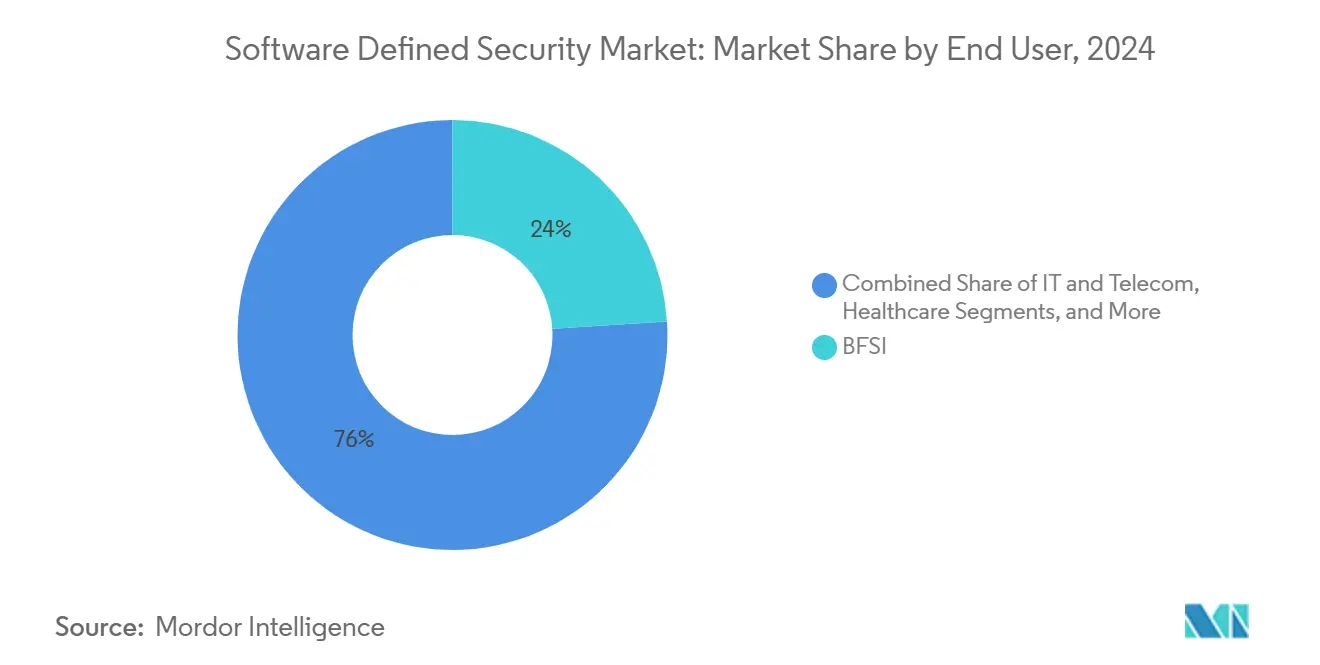
Note: Segment shares of all individual segments available upon report purchase
By Component: Services Gain Momentum Amid Software Leadership
The software defined security market size for software platforms remained dominant at USD 8.1 billion in 2024, translating into a 63% revenue share. Yet the services sub-segment is set to advance at a 15.60% CAGR through 2030, outpacing core license growth. Enterprises recognize that policy automation, threat modelling, and infrastructure-as-code disciplines demand skills that internal teams often lack. As a result, managed detection-and-response specialists see surging demand for project staffing, continuous monitoring, and compliance documentation.
Professional services partners fill this gap by designing zero-trust blueprints, mapping business processes to micro-segmented networks, and coding workflow integrations that orchestrate incident response. Vendors such as Cisco deepened service portfolios when they closed the USD 28 billion Splunk acquisition in March 2025, merging analytics with hands-on advisory offerings. This pairing helps customers rationalize tool sprawl and keep pace with evolving regulations, further cementing the software defined security market’s service opportunity.
Geography Analysis
North America captured 38% of 2024 revenue, underpinned by decisive federal action. The U.S. Department of Defense allocated USD 504.9 million to DISA cyber operations for fiscal 2025, with a mandate to build zero-trust reference architectures that ripple into contractor ecosystems. Corporate boards mirror that urgency: overall cybersecurity spending in the region grew 15% year over year, buoyed by the White House’s executive orders that require software bills of materials and continuous monitoring across the federal supply chain. [3]U.S. Department of Defense, “Fiscal Year 2025 Budget Estimates,” comptroller.defense.gov
Europe sits in second place but posts healthy acceleration as the software defined security market aligns with sweeping legislation. The Cyber Resilience Act coming into force in December 2027 obliges manufacturers to design products with security baked in from day one. Complementary measures such as the Digital Operational Resilience Act (for finance) and NIS2 (for essential services) extend similar obligations across the economy. Enterprises are therefore converging on programmable policy engines capable of proving compliance in real time to multiple supervisory bodies. [4]European Union, “Cyber Resilience Act,” digital-strategy.ec.europa.eu
Asia–Pacific is the growth frontrunner, set to log a 14.90% CAGR through 2030. Manufacturing heavyweights in China, Japan, and South Korea pursue Industry 4.0 programs that expose operational-technology networks to internet threats. Governments respond with sector-specific frameworks that recommend micro-segmentation and zero-trust, propelling new projects. India’s Digital Personal Data Protection Act similarly raises bars for healthcare and e-commerce operators. Collectively, these moves expand the regional share of the global software defined security market.
The Middle East, Africa, and South America are emerging adopters. Energy exporters commission secure-by-design refinery control systems, while Brazilian financial regulators publish stringent open-banking security guidelines. Although absolute spend remains lower, high growth rates make these geographies attractive for cloud-native vendors seeking greenfield opportunities.
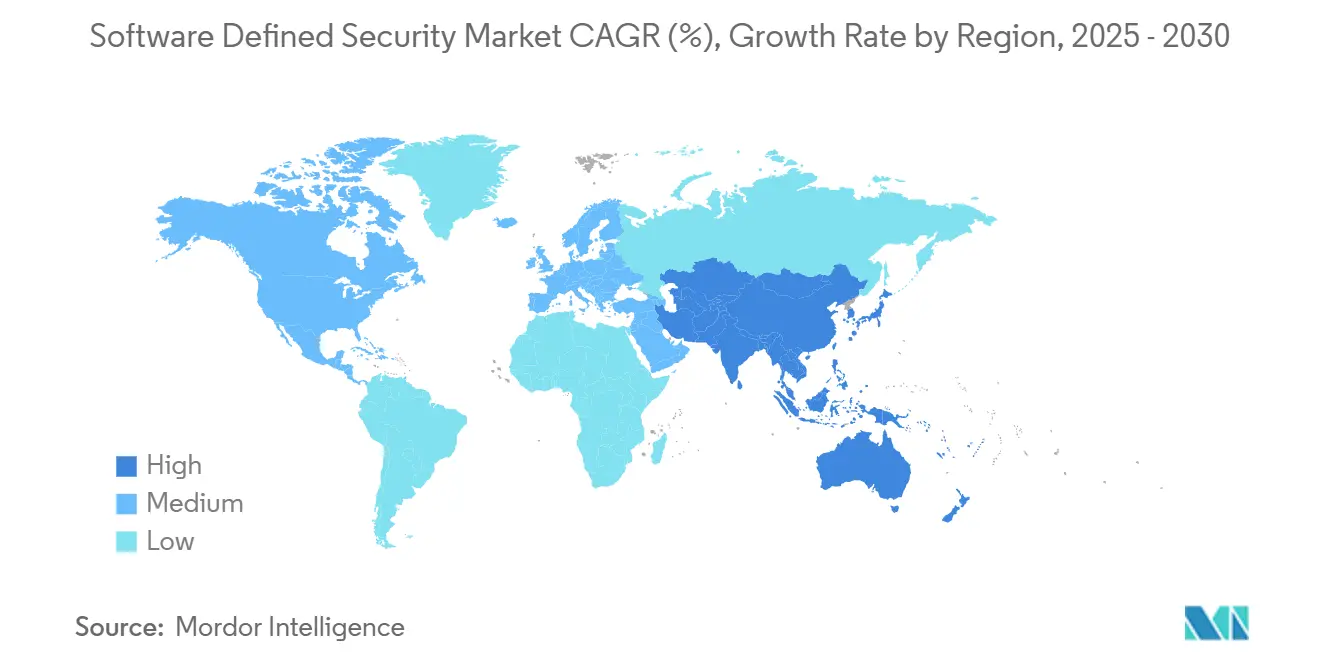
Competitive Landscape
The software defined security market is moderately concentrated yet fiercely contested. Established networking players—Palo Alto Networks, Fortinet, Cisco, and Check Point—leverage proprietary ASICs and consolidated operating systems to bundle network, endpoint, and cloud controls under a unified license. Cisco’s 2025 integration of Splunk strengthens its analytics posture, pairing log ingestion with real-time automation hooks. Fortinet’s Security Fabric follows a similar path, anchoring zero-trust edges on homegrown silicon for high-throughput inspection.
Cloud-native challengers such as Zscaler, CrowdStrike, and Netskope differentiate through multi-tenant architectures that scale instantly without customer hardware. Zscaler’s FY 2025 roadmap emphasizes inline data-loss prevention and direct-to-cloud micro-segmentation. CrowdStrike extends Falcon modules into Kubernetes runtime visibility, translating endpoint telemetry into workload-specific policies.
Strategic acquisitions accelerate innovation cycles. Sophos’ late-2024 purchase of Secureworks broadens its managed detection portfolio, while Darktrace’s 2025 updates add self-healing network loops and risk-weighted visualization tools. Investors continue to fund point solution start-ups that fill gaps in identity-centric segmentation, cloud permissions management, and operational-technology threat hunting, ensuring a steady inflow of specialized features into broader suites.
Vendor differentiation now hinges less on raw detection accuracy and more on how seamlessly controls integrate into DevOps pipelines. Open REST APIs, Terraform providers, and workflow orchestration drive buyer preference. Over the forecast period, platformization is expected to consolidate market shares further as enterprises reduce tool sprawl, but ample niche space remains for innovators that address container isolation, machine-to-machine authentication, and post-quantum cryptography readiness.
Software Defined Security Industry Leaders
-
Palo Alto Networks
-
Cisco Systems
-
Fortinet
-
VMware (Broadcom)
-
Check Point Software
- *Disclaimer: Major Players sorted in no particular order
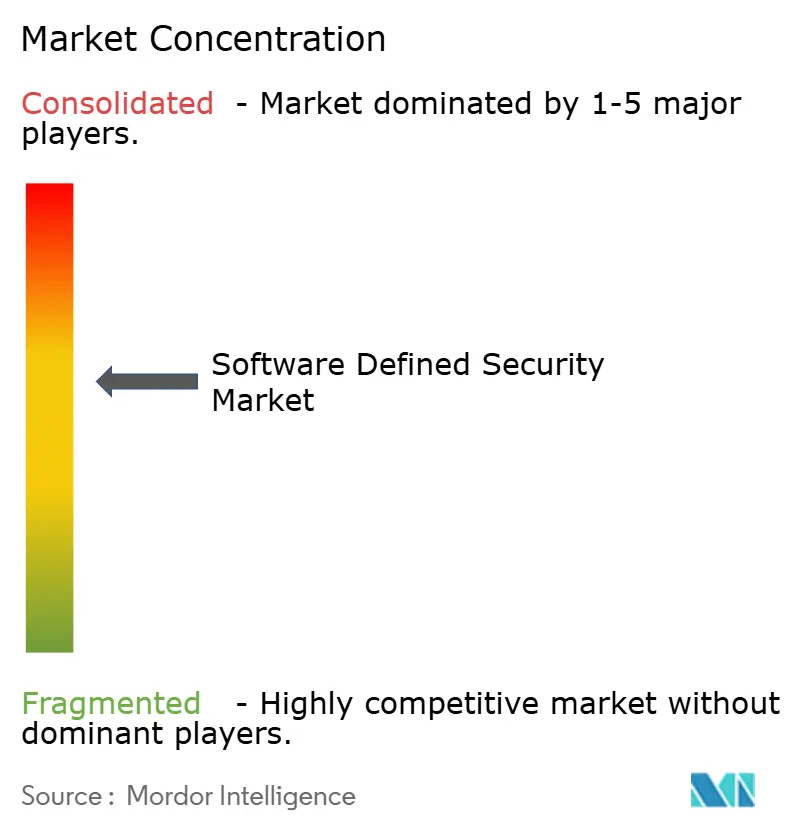


Recent Industry Developments
- May 2025: Broadcom posted USD 14.9 billion Q1 2025 revenue, highlighting VMware Cloud Foundation wins in federal and enterprise accounts, underscoring the pivot toward integrated software-defined stacks
- April 2025: Cisco unveiled Instant Attack Verification and automated XDR forensics at RSAC 2025, alongside a ServiceNow partnership that links security alerts to enterprise risk dashboards
- April 2025: Darktrace expanded autonomous response features within its Network Detection and Response product and added integrations with Netskope and Zscaler for unified hybrid-work visibility
Research Methodology Framework and Report Scope
Market Definitions and Key Coverage
Our study defines the software-defined security (SDS) market as every security function, network, endpoint, application, container, and orchestration delivered or controlled through programmable software that decouples policy from underlying hardware. Coverage spans on-premise, public, private, and hybrid-cloud deployments alongside associated support services.
Scope exclusion: Stand-alone, hardware-only firewalls or physical appliances with no programmable interface are not counted.
Segmentation Overview
- By Component
- Software
- Services
- By Deployment Model
- On-premises
- Public Cloud
- Private Cloud
- Hybrid Cloud
- By Security Type
- Network Security
- Endpoint Security
- Application Security
- Cloud / Container Security
- Others
- By Organization Size
- Small and Medium Enterprises
- Large Enterprises
- By End User
- BFSI
- Telecommunications and IT
- Healthcare
- Government and Defense
- Retail and eCommerce
- Energy and Utilities
- Others
- By Geography
- North America
- United States
- Canada
- Mexico
- Europe
- United Kingdom
- Germany
- France
- Italy
- Rest of Europe
- APAC
- China
- Japan
- India
- South Korea
- Rest of APAC
- Middle East
- Israel
- Saudi Arabia
- United Arab Emirates
- Turkey
- Rest of Middle East
- Africa
- South Africa
- Egypt
- Rest of Africa
- South America
- Brazil
- Argentina
- Rest of South America
- North America
Detailed Research Methodology and Data Validation
Primary Research
Mordor analysts spoke with CISOs, cloud architects, managed detection and response providers, and value-added resellers across North America, Europe, and Asia-Pacific. Insights on endpoint counts, average spend, container rollout pace, and budget intentions helped us verify secondary findings and close information gaps.
Desk Research
We reviewed reputable, open sources such as the U.S. CISA Zero-Trust Roadmap, ENISA Threat Landscape, NIST SP-800 series, OECD ICT spend tables, and national customs records for security software HS codes. Public company 10-Ks, investor decks, and alerts were paired with news archives from Dow Jones Factiva and financial snapshots from D&B Hoovers. These references illustrate our evidence base; many additional sources supported data collection, validation, and clarification.
Market-Sizing & Forecasting
The model starts with worldwide enterprise IT spend, isolates the security allocation, and then applies penetration rates for SDS across workloads, endpoints, and containers. Supplier roll-ups and sampled average selling prices test totals before adjustment. Key variables include public-cloud workload volume, Kubernetes adoption, average security spend per workload, regional compliance intensity, and GDP-linked IT budget growth. A multivariate regression forecasts each driver, and scenario analysis captures upside from zero-trust mandates. Where vendor revenue is missing, proxy ratios from similar listed peers bridge the gap.
Data Validation & Update Cycle
Outputs undergo algorithmic variance scans, senior analyst peer review, and a pre-publication refresh. Reports are rebuilt every twelve months, with mid-cycle updates triggered by material events, ensuring clients receive the latest view.
Why Mordor's Software Defined Security Baseline Earns Trust
Published estimates often differ because firms select unique scopes, base years, and assumption stacks. Mordor chooses a consistent boundary, refreshes annually, and exposes driver-level logic, keeping our baseline tightly aligned with market reality.
Key gap drivers elsewhere include bundling adjacent SD-Networking revenues, applying aggressive multi-year license multipliers, or ignoring SME cloud adoption lags. We limit scope to genuine SDS spend, validate every assumption in interviews, and convert currencies at average calendar-year rates.
Benchmark comparison
| Market Size | Anonymized source | Primary gap driver |
|---|---|---|
| USD 12.90 B (2025) | Mordor Intelligence | |
| USD 11.20 B (2023) | Global Consultancy A | Includes only public-cloud use cases; omits service revenues |
| USD 12.24 B (2024) | Industry Journal B | Relies on top-down spend share without primary validation |
| USD 15.80 B (2024) | Regional Consultancy C | Adds broader SDx categories, inflating baseline |
The comparison shows that Mordor's restrained boundary setting, mixed-method modeling, and timely refresh deliver a balanced, transparent figure decision makers can rely on.


Key Questions Answered in the Report
What is the current size of the software defined security market?
It is valued at USD 12.9 billion in 2025 and is projected to reach USD 26.91 billion by 2030.
Which component segment grows fastest?
Services, expanding at a 15.60% CAGR as firms seek external expertise to operationalize zero-trust and multi-cloud policies.
Why is Asia–Pacific the fastest-growing region?
Manufacturing digitalization, national cyber-security strategies, and rapid cloud adoption lift regional demand, driving a 14.90% CAGR.
How does zero-trust architecture influence purchasing decisions?
It requires continuous verification and granular segmentation, both of which favor programmable security platforms over traditional appliances.
What skills gap challenges deployment?
A shortage of DevSecOps professionals raises project costs and slows rollouts, prompting many organizations to hire managed service providers.
Which vertical is expected to see the highest growth through 2030?
Healthcare, at a 16.40% CAGR, as hospitals harden defenses after high-profile breaches.
Page last updated on:
